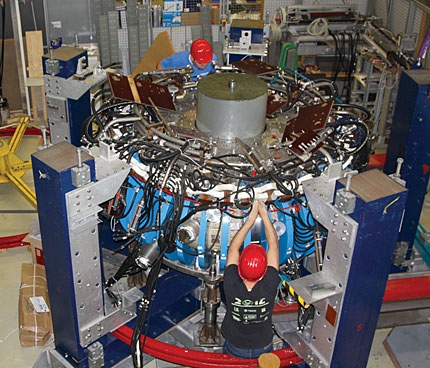Fusion experiment crosses ocean
DOI: 10.1063/PT.3.2582
En route to the University of Illinois at Urbana-Champaign is a small fusion reactor, a gift from the Max Planck Institute for Plasma Physics in Greifswald, Germany. Some 70 tons of dismantled parts were shipped out in late September. The reactor, a tokamak and stellarator rolled into one, will be rechristened the Hybrid Illinois Device for Research and Applications (HIDRA).
Understanding the interactions between the plasma and the containment walls will be the primary focus at HIDRA, although it will also be used for other studies and for training.
The reactor (shown at right during dismantling) got its start in 1975 in Grenoble, France, and spent time in Stuttgart, Germany, before opening shop in Greifswald in 2001. “The beauty is that it was made very well. That’s why it has existed so long and why it will be useful to us,” says David Ruzic, director of the Center for Plasma-Material Interactions at Urbana-Champaign. The university is ponying up about $1 million to cover the move, reassembly, 2.2 MW of power, staff, and about two years of operation.

IPP, IRIS WESSOLOWSKI

At Greifswald, meanwhile, scientists needed to make room for the larger Wendelstein 7-X, which will start up next year with the purpose of demonstrating that a stellarator can attain the parameters necessary for a fusion power plant. The US is participating in the €370 million ($460 million) German-led European project.
More about the Authors
Toni Feder. tfeder@aip.org
